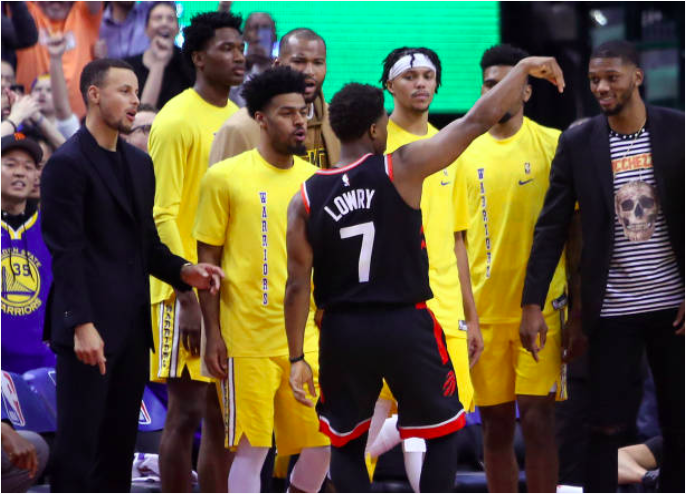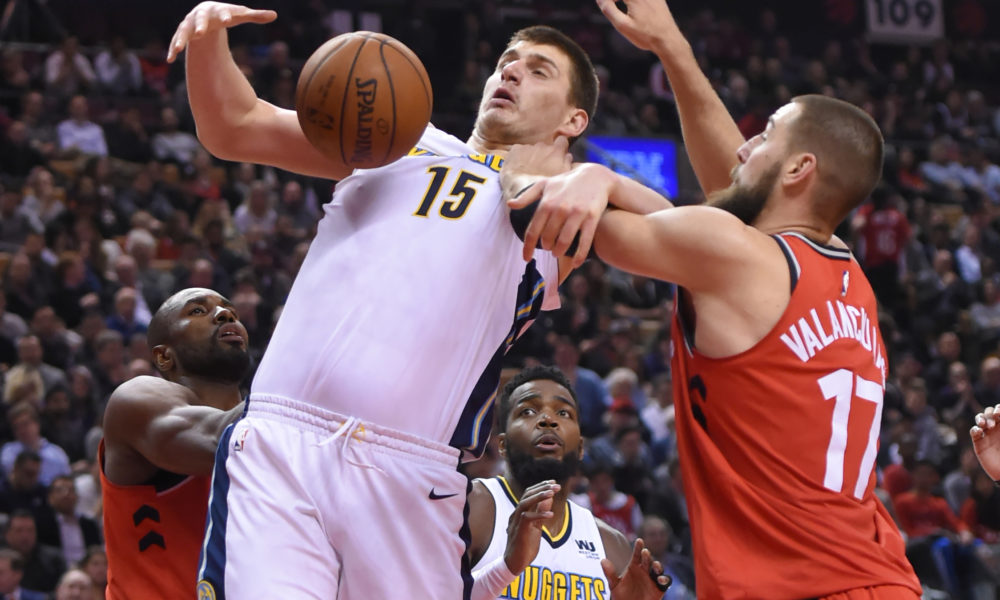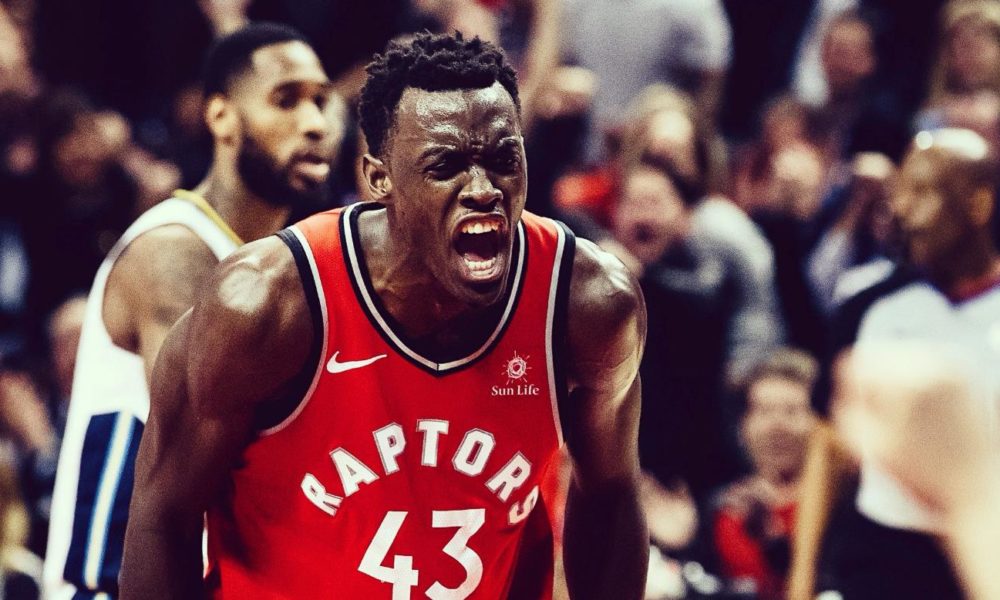The Toronto Raptors are not yet at their best. This is not to say that they haven’t yet played a full game. ‘A full 48 minutes’ is a mostly antiquated phrase, which doesn’t take into account the actual variance that takes place within the 200 or so possessions that make up a game. Teams can get good shots, hold opponents to poor shots, and still lose; it happened to the Raptors against the New Orleans Pelicans.
The Raptors are not yet at their best because they have easily identifiable problems, most specifically in the minutes whenever their starters are not all on the court. If that grouping of minutes could be improved, then a number of Toronto’s wins would have required fewer fourth quarter heroics.
Toronto’s problems have occurred in very specific sections of games. When Toronto plays an ‘all-bench lineup’, they have been rocked by opponents. That remains true in the transitional periods when the Raptors have a few starters left on the floor and a few bench players joining them. This occurs at the ends of the first and third quarters, and the start of the second and fourth quarters, adding up to approximately 8-12 minutes per game before the starting lineup or a slight variation cycles back into the game.
Let’s compare how Toronto plays with no starters on the floor, with some starters on the floor, and with all of their starters on the floor.
All stats taken from pbpstats.com
| No Starters | Some Starters | All Starters | |
|---|---|---|---|
| Number of minutes (league rank) | 167 (4) | 534 (28) | 461 (1) |
| Expected eFG (league rank) | 0.51 (14) | 0.51 (11) | 0.52 (15) |
| Actual eFG (league rank) | 50.8 (11) | 51.91 (11) | 62.40 (1) |
| Rim + 3 frequency (league rank) | 77.64 (6) | 69.01 (15) | 66.71 (19) |
| Points per 100 possessions (league rank) | 104.67 (11) | 108.42 (21) | 128.74 (first by more than 7 full points, lol) |
| Opponent points per 100 possessions (league rank) | 114.76 (24) | 108.53 (9) | 103.59 (5) |
| Seconds per offensive possession (league rank) | 13.70 (17) | 14.13 (22) | 13.25 (5) |
| Seconds per defensive possession (league rank) | 13.03 (23) | 13.44 (26) | 14.80 (3) |
| Assists per 100 possessions (league rank) | 21.98 (17) | 22.63 (18) | 29.57 (4) |
This is a monster chart, and it may take a minute to digest. Don’t worry; it took a fair number to create. There are a few key takeaways. Toronto has been the best team in the league by a laughable margin when it has all of its starters on the court. Their 128.74 points per 100 possessions is superior to Kevin Durant’s individual mark of 125.4; when the Raptors’ starters are on the court, an average shot is superior to one from Kevin freaking Durant.
The starters do this by controlling the pace. They play fast while force opponents to play slow. The starters pass the ball well, even if they don’t take the mathematically optimal distribution of shots. This is true because usual-starters Serge Ibaka and Kawhi Leonard take 46 and 50 percent of their shots from the midrange, respectively (both frequency levels above 90th percentile in the league for their positions). It works, especially because Ibaka is shooting 54 percent and Leonard 47 percent from such distances.
Among the three groupings, the starters take the fewest percentage of their shots from deep or at the rim, yet they average by far the most points. This is probably just evidence of a fairly axiomatic truth that the starters play better simply because they have more talent, not because they actually find better shots.
Late in the first quarter, the Raptors will generally substitute one center for the other, and those lineups remain quite successful. A few minutes later, the Raptors substitute the starting wings for a few bench wings (usually one of whom is actually a point guard). Those transition lineups are the trouble lineups; according to Cleaning the Glass, lineups without Danny Green and Kawhi Leonard have been outscored on the season by 5.1 points per 100 possessions. That’s right in line with pbpstats’ marks for transitional lineups on the whole.
That transitional lineup specifically, (Lowry-FVV-Anunoby-Siakam-Valanciunas) was outscored by six points in only two minutes to the Warriors in a recent win, allowing the Dubs back into the game at the bottom of the second quarter. Three of their first four offensive possessions were turnovers, and they looked quite disjointed.
A similar lineup, with Leonard in place for Lowry, allowed Golden State to close the gap at the start of the fourth. While every lineup other than the horrible transition ones vacillated between -3 and +2, the original starters outscored Golden State by a whopping 13 points in 34 minutes played together. That was the source of the victory.
Beyond just the Golden State game, Lowry’s presence alone hasn’t ensured offensive competence. The Raptors have only managed to score 93.8 points per 100 possessions with him on the floor and Siakam and Green off. Lineups with Leonard in the same situation have been equally poor. Note that this silly CJ Miles turnover occurs when Miles decides to run the pick-and-roll, despite one of the league’s best pnr handlers in Lowry being on the court and waiting for a pass.
At the top of the second and fourth quarters, the Raptors generally play five bench players together. After famously waxing opponents last year, that unit hasn’t yet clicked for Toronto. Partially because Jakob Poeltl is gone, and partially because Siakam is now playing with the starters, the bench lineup hasn’t clicked. Anunoby hasn’t appeared ready to create his own share of the offence, and Van Vleet has been up-and-down as the primary offensive creator in the pick-and-roll.
Van Vleet’s shooting in particular has been instructive as a microcosm of the Raptors’ whole, as he hasn’t simply become an ineffective player. When he is pushed off-ball with Lowry alongside him, he’s shot 45.8 percent from deep. When he has played as the lead guard, with Lowry on the bench, Van Vleet has shot 27.8 percent from deep. Along with injury hampering Van Vleet for much of the season so far, the Raptors’ have likely asked too much of him when he’s on the court. Delon Wright could be asked to do slightly more and Van Vleet less with the ball.
The all-bench and transitional lineups for the Raptors have struggled despite taking mathematically superior shots. Though the all-bench lineups have led the Raptors in attempts from beyond the arc or at the rim, they have had trouble converting good looks on offence. They struggle to create offence for each other, and like last year, many half-court possessions end up as last-second bailouts. On the other end, they bleed points and have trouble slowing opponents’ pace.
So, no, the Raptors have not yet reached their best potential play yet this season. However, it’s not as far away as some might think. A simple answer to solving their all-bench problem would be to dispose of it entirely. The Raptors aren’t looking to win every minute in the regular season, but come playoffs, they should keep one of Lowry and Leonard on the floor at all times. They’ve done that in recent games against playoff teams in Memphis and Golden State; curtains may have already been called for regular minutes for the all-bench lineup.
That won’t solve every problem. Transitional lineups have also struggled, though not nearly as much as all-bench lineups. That Toronto has been slightly outscored over the year with 1-4 starters on the floor is problematic and a continuation of trends established last year. One bet is that if Toronto’s transitional lineups are given more minutes – they currently rank almost last in the NBA – they will have more of an opportunity to establish a successful pattern. Lineups generally need in-game minutes to learn chemistry and start playing well together.
The transitional lineups have actually stayed afloat, only being outscored by minuscule amounts in their league-low minutes on the floor; meanwhile, the all-bench lineups have been slaughtered in their league-leading minutes. If the Raptors were to steal some minutes from their horrible lineups and give them to their only-mediocre lineups, that would be an immediate boost (and will surely happen in the playoffs).
If you dig into more granular levels, there are other ways to help the transitional lineups. Lowry-Green-Leonard alongside Anunoby and Valanciunas as the bigs have outscored opponents massively in only 26 possessions. This has been proposed by others before, including Blake, but subbing the bigs before the wings at the bottom of the first quarter could help Toronto.
One or both of Siakam and Ibaka could return to the floor early in the second quarter to boost the bench. Lineups with Siakam and Ibaka as the twin bigs – but without any other starters – have outscored opponents by ridiculous margins in only 38 possessions. Siakam is an additional creator, and his scoring and passing allows opportunities for offensively challenged lineups to get some easy looks that otherwise might not be available.
The Raptors starters’ rampage across the league has spurred the team’s 20-4 start. The weaknesses of transitional and all-bench lineups have allowed opponents to win at least two games, and to fight back into a variety of others. It’s possible that the weak Raptors’ lineups have been unsuccessful because they’ve used the wrong personnel, but depth was supposed to be a strength of Toronto coming into the season.
The Raptors could always employ the tyranny of Tom Thibodeau and play their starters 42 minutes a game together. Or, they could change the rotations slightly to give bench players more beneficial skill and chemistry pairings. Ryan Nguyen and Ben Falk wrote a great piece last year about how the Raptors’ bench found success.
“The answer to this puzzle seems to lie in the way all of the pieces fit together — and a coaching staff that has assembled these pieces intelligently,” they wrote.
By changing the substitution patterns of Anunoby and Siakam, among others, the Raptors could reassemble their puzzle this year by fitting the pieces together more intelligently. Coach Nick Nurse has admitted that he’s still learning on the job, and his reputation as ‘creative’ and ‘experimental’ would point towards him eventually trying slightly different rotation patterns.
It’s unreasonable to expect the Raptors to start winning games by 40 or more; that’s beyond the desired level of improvement. However, the Raptors do need to stop letting opponents back into games after taking 10-15 point leads. They may lead the league in wins by a full five games, but the Raptors will improve. This team’s floor is so high that it’s easy to overlook problems. Whether that is a silver lining or problematic crutch remains to be seen.



